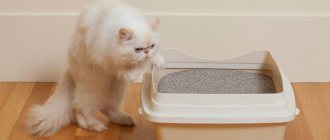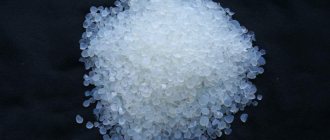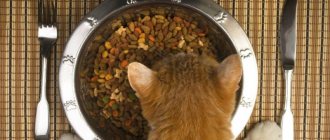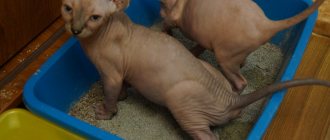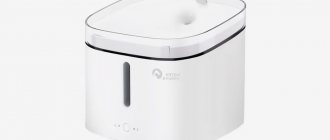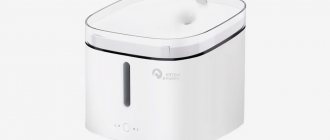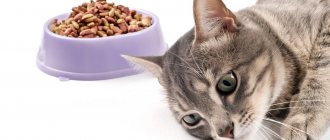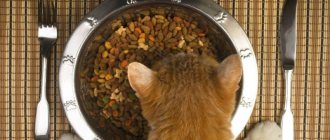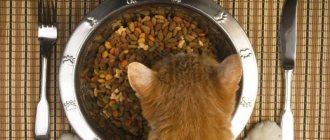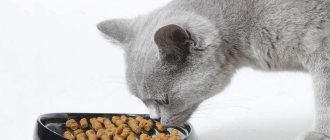What is the best cat litter to choose?
First of all, the answer to this question can be found out by the behavior of the animal - if the cat goes to the litter box without problems, it means that everything suits her. But if she refuses to use it or the animal is new to inexperienced owners, purchasing litter becomes difficult.
What types of fillers are there and how are they different?
There are paper, gel, silica gel, mineral, corn, wood, soy, and bentonite materials. They can be distinguished by their composition, appearance, basic properties and principles of action. And, of course, they have different prices.
All materials are divided into two types - absorbent and clumping. The former absorb and retain moisture without losing their structure. The entire filler should be changed at least once every 2-5 days, if not more often.
The operating principle of the clumping composition is based in such a way that upon contact with liquid it forms small lumps. You can simply remove them from the toilet along with the feces and add the same amount of new litter. But some cats are capricious and categorically refuse to go to the litter box even a second time.
In this case, it becomes necessary to completely replace the contents of the tray, and not just the wet areas. Therefore, sometimes in order to understand which one is better, it takes practice.
What can you flush down the toilet?
All those substances whose granules do not swell or increase in size can be disposed of in the sewer system. But, in any case, you should not throw away the contents of the tray, even large volumes of natural wood material, to avoid clogging the pipe.
The disposal method is usually indicated on the packaging. Therefore, you must definitely read the instructions.
Some types of modern litter can be flushed down the toilet. However, this can only be done if there is a corresponding mark on the packaging. In addition, you cannot pour a large volume of filler down the drain, otherwise there is a risk of clogging the toilet even with soluble waste
Which filler best removes odor and leaves little litter?
Clay-based products, whether scented or not, are very good at locking in odors. Silica gel fillers will also do the job well, but only with large granules. They are more expensive, but ultimately more economical - replacement is required only once every three weeks.
This material also absorbs moisture well, does not remain on the animal’s paws, and there is no dust from it. In addition, these two types of fillers will cope even with the sharp and unpleasant aroma of urine of sexually mature individuals due to hormones.
Where to put the cat potty?
Since the dimensions of the tray for Maine Coons are usually large, the question arises where to place it. The traditional place for a cat's litter box is the bathroom. There it is easier to wash the tray, throw away contaminated litter and wipe the animal’s paws as necessary. The door to the room must always be slightly open, or you will have to cut in a door specifically for the coon. Trays are placed on closed loggias, in hallways - usually in those places that the animal chooses. The place for the cat's toilet should be quiet, secluded, and most importantly, the coon should have time to reach it on time. If the house has several floors and the pet moves freely between them, you should place a tray for the Maine Coon on each floor.
In order for the new kitten to understand where his litter box is, it is recommended to take some dirty litter from the nursery and mix it with the contents of the new tray. A familiar smell will help the little Maine Coon get comfortable in an unfamiliar environment.
How to choose litter for different cats and kittens
When choosing a toilet for a cat, it is necessary to take into account the breed, its physiological and psychological characteristics, as well as its age.
For Maine Coon and other long-haired breeds
The Maine Coon has a distinct character with its own habits and special behavior, and when choosing a product for this breed, you need to consider the following:
- cats love to throw it around;
- they have rather thick and long hair, so they get very dirty;
- Not every filler is accepted.
Some of the best litter options for Maine Coons are wood and silica gel.
The latter has amazing moisture-absorbing properties and is economically consumed. Litter granules for litter trays for adult cats should be medium or large in size.
Some of the best filler options for Maine Coons are wood and silica gel.
For Scots and Brits
Scottish and British cats are more flexible. If you educate them from early childhood, you can accustom them to any type of filler. Considering that they are short-haired, it is not necessary to use a large fraction as a filler in the tray.
These can be wood, clay, mineral and silica gel products.
Most often, clumping wood pellets are used for these species. They easily get used to the bedding; in addition, wood filler is one of the most environmentally friendly of all types and cats really like it.
For small kittens
If we think from an environmental point of view, then the choice falls on wood bedding. However, it is not suitable for small kittens - wood pellets swell when wet, and playful kittens love to taste everything. Therefore, sawdust filler is dangerous.
Silica gel is also unsafe for kittens.
They can also eat pellets, which, when ingested, absorb all the moisture, which can subsequently lead to blockage of the gastrointestinal tract. The best alternatives are moisture-absorbing clay, corn and soy products.
Wood pellets are not the best option for small kittens who want to taste everything, including swollen sawdust.
Types of trays for Maine Coons
For an older coon, a box tray with a closing door is suitable. It is important to choose a toilet in which the animal will feel comfortable - if it is difficult to find a closed tray for large cats, the same design for lap dogs is suitable. Indoor tray houses are equipped with replaceable carbon filters that absorb odors.
If you choose an open tray, it must have high sides - Maine Coons love to dig into the litter. As a result, the area around the cat's litter box will be littered, and small particles of litter will be spread throughout the apartment. The edges of the sides should be curved inward, and it is advisable to lay a rubber mat in front of the Maine Coon tray.
Sometimes, if it is not possible to purchase a standard tray for a large breed cat, Maine Coon owners use large plastic containers with high sides - bathtubs, storage boxes, trays and other similar items - as a toilet. [ads-pc-1]
A REMINDER FOR CARING FOR A MAINE COON KITTEN
first day in a new house
The first thing you need to take care of is preparing a tray with filler. Pour the litter from the parent's house on top of the new one, and place the Maine Coon kitten there as soon as you release it from the carrier. On the first day of stay, it is advisable to limit the kitten’s movement throughout the house to the space that includes its toilet, bowls of food and water, and sleeping place. Make sure that the baby understands where to do his “business”. Watch him very carefully at first. If the kitten does not go to the litter box right away, periodically put him there, reminding him where the “place” is. As a rule, Maine Coon kittens after 3 months immediately understand what’s what and there are no problems with this. Especially provided that you bought exactly the filler that was used in your parents' house.
Show the kitten where the water and food are, play with him, attracting him to the place where you need to sharpen his claws. In the game, make sure that the kitten scratches on the scratching post prepared before his arrival. Determine in advance whether you will allow the kitten to climb onto the kitchen table, and do not allow him to do this; say in a confident voice: “No!” and resolutely remove from the prohibited territory. Cats are very smart creatures and quickly understand what's what.
Which tray and filler should I choose?
Choose the shape and design of the tray, taking into account the characteristics of your home and the rule that the larger it is, the better for the Maine Coon. I really love Ferplast Maxi Bella tray houses. They look aesthetically pleasing in an apartment anywhere, and Maine Coons, who like to carefully bury “their business,” cannot spill the filler during intensive paw work . I immediately remove the door in such house trays and never use it, considering it useless J. If you choose an open tray, then let it have sides. The shape doesn't matter, just the bigger the better. I use Cat's Best Oko Plus wood clumping litter for small kittens and Ever Clean bentonite clumping litter (or its analogues) for adult Maine Coons and kittens after two months of age. I see only one downside to this filler - it easily spreads around the apartment on the fur and paws. Next, you can experiment with types of fillers, now there are a lot of them. I like the clumping one better, the tray stays clean longer and there is no smell.
I really love Ferplast Maxi Bella tray houses. They look aesthetically pleasing in an apartment anywhere, and Maine Coons, who like to carefully bury “their business,” cannot spill the filler during intensive paw work . I immediately remove the door in such house trays and never use it, considering it useless J. If you choose an open tray, then let it have sides. The shape doesn't matter, just the bigger the better. I use Cat's Best Oko Plus wood clumping litter for small kittens and Ever Clean bentonite clumping litter (or its analogues) for adult Maine Coons and kittens after two months of age. I see only one downside to this filler - it easily spreads around the apartment on the fur and paws. Next, you can experiment with types of fillers, now there are a lot of them. I like the clumping one better, the tray stays clean longer and there is no smell.
what to feed? There are 3 types of feeding: natural, mixed and only industrial food.
I feed adults only industrial dry food of the holistic and Super Premium classes. Holistics are a new generation of food that is not advertised in Russia and many have not even heard of them. Fully balanced, environmentally friendly products are used for their preparation. If you choose food of this class, the kitten does not need additional vitamins and supplements. Also, as the animal grows, there is no need to switch it to food for adults or castrates; holistic food is suitable for everyone at the same time: kittens, adults, and castrates. The only downside is that you can’t buy them everywhere. My Maine Coons eat POWER OF NATURE Active Cat / Cookie's Choice with pleasure. If it is impossible to buy these foods in your city, that's okay. Super premium dry food is also perfect, such as: Pro Plan Junior for kittens Chicken with Rice or Royal Canin Kitten Maine Coon 36 for kittens. But in this case, you should keep in mind that from 10 months you will need to switch from dry food for kittens to food for adults. Preferably from the same manufacturers.
There is nothing wrong with pampering your Maine Coon with fresh meat if you are dry feeding. When raising kittens, I add turkey and chicken gizzards to dry food once or twice a day. It is also good to give veal or beef and quail eggs 1 piece 3 times a week. Under no circumstances should you eat pork. Whatever fresh meat you choose, it should be lean. Divide fresh meat into portions of 100-200 g and freeze for at least 48 hours in the freezer. This kills parasites and harmful bacteria that may be present in fresh meat. Before giving already frozen meat products to your Maine Coon kitten, be sure to defrost them completely and let them warm up to room temperature. By adding meat and shrimp to the dry diet of a Maine Coon kitten, we introduce an imbalance in the calcium-phosphorus metabolism. The level of calcium and phosphorus in the blood should be approximately 1:1. Meat is phosphorus. Calcium is bones, cartilage, cottage cheese. But our cats don't eat enough bones and curds to meet the level of phosphorus they get from meat. The parathyroid gland regulates the level of calcium and phosphorus in the blood by releasing a hormone into the blood. And it is not phosphorus that lowers it to the level of calcium, but calcium that should be raised to the level of phosphorus. Where does the body get calcium if it doesn’t come from food? From bone tissue. Therefore, calcium is washed out of the bones to normalize its level in the blood and other tissues. Hence - crooked paws, fractures, early loss of teeth, and generally a slight weak bone structure. Therefore, if you feed the Meny Coon mixed, then you need to add 150 mg of calcium to every 100 grams of meat he eats. And calcium should not be “8in1” - synthetic, but natural. Such a drug is available from Canina (Cat-Mineral Tabs). There are calcium preparations from a regular pharmacy such as Sea Calcium (from marine invertebrates), Mountain Calcium, Calcide (from eggshells). Calcium should be natural or in an easily digestible form. For example: 100g of raw meat contains 150 mg of phosphorus (and 10 mg of calcium itself); dairy products contain the correct calcium-phosphorus ratio, but cannot compensate for excess phosphorus in the body. Whatever new food you give your kitten, always monitor the condition of the animal’s stool after it. If intestinal upset begins, cancel all innovations and leave the usual food. No sausage, smoked meats, salty or fried foods (plant the liver or pancreas). Maine Coons, like all cats, are very fond of roach, caviar (salted) and smoked squid, but this is not allowed . They like to lap up tap water, but you shouldn’t, you can only drink filtered or bottled water. They love shrimp very much, you can give them as a treat, but a little at a time, just defrosted.
feeding bowls
When choosing dishes for a Maine Coon kitten, keep in mind that Maine Coons love to rake water with their paws and a huge puddle J often forms around a bowl of water. Therefore, a tray with bowls is an ideal option. If you have one kitten in the house, small ones with a volume of 0.3 liters will do. Do not add a lot of dry food at once so that it does not dissipate. Add more as you eat it. And always make sure that the water in the bowl is clean, coons love to rinse their paws in water, as a result, the water quickly becomes dirty, it is better to change it more often.
safety
Avoid toys with glitter and rubber bands. These are dangerous, fatal, and may cause intestinal obstruction. The same warning applies during the winter holidays; it is better to throw the Christmas tree “rain” away. Threads and needles should generally be locked tightly, cats love to swallow threads and ropes, and suddenly they get tangled in the intestines or there is a needle at the end. Cats are very afraid of drafts. As with small children: all chemicals, shampoos, washing powders are out of reach (they can spill, step on, then lick themselves off - and here it is, poisoning). Make sure that the windows are barred, Maine Coons can easily “fly” after birds and butterflies... and break :-( top ventilation is also fraught with injuries (suffocation). Do not rely on the mosquito net to protect your Maine Coon from falling out, it has been verified that they will Analyze all furniture for opening, jumping, pinching; by jumping from a cabinet or falling off a curtain, a kitten can get injured (imagine a baby in a cast and check everything again).
toys
Climbing houses, balls (safe, not odorous, not crumbly, not to be bitten, not to be swallowed), flyers, fishing rods, preferably leather or fur. Mine love juice straws and hair ties, as well as anything that rustles, rattles, or rings. If you have claws, we’ll sharpen them; if you don’t have a scratching post, they’ll tear up furniture or wallpaper. Scratching posts and climbing frames must be purchased BEFORE the kitten arrives in the house. I recommend climbing frames and houses from companies from St. Petersburg. They are reliable, fit perfectly into the interior and are ideal for Maine Coons. Give preference to houses with thick pillars and a comfortable top shelf for relaxation. Delivered to Moscow within 10-14 days, they can make any complex according to your project. These complexes can also be purchased at major cat shows in Moscow.
care
From the first weeks of your Maine Coon kitten's stay in the house, get him used to brushing so that it becomes a habitual procedure for him. First, simply stroking it with one hand along the back, and with the other hand, run a comb along the back, alternating. Do not try to comb the tail, otherwise it will not be fluffy. When combing, pay special attention to the panties, armpits, tummy and collar. The ideal comb, in my opinion, should be steel: Artero Comb long pins 18cm and its analogue Andis 7 1/2″ Steel Comb.
I advise you to trim your claws with a nail clipper, especially if you have small children. While playing, kittens may accidentally scratch your baby. We cut off only the transparent part of the claw without damaging the pulp. If you accidentally injure the pulp due to inexperience, do not panic, but simply apply cotton wool with hydrogen peroxide to the claw, the blood will quickly stop.
It is better to bathe a Maine Coon kitten as needed, if you see that the fur is very dirty, with icicles, or after the summer season. For this procedure, I recommend 3 products that, in my opinion, are irreplaceable and have no analogues in pet stores. This is American cosmetics for animals Groomer`s Goop. First, apply degreasing paste to dry wool, thoroughly rubbing it into particularly dirty areas of the coat. Leave for at least 5 minutes and rinse completely with very warm water. Apply degreasing shampoo, massage thoroughly over the entire body for 5 minutes and then rinse just as thoroughly. The final stage is air conditioning. At this stage, it is important not to overdo it with the amount, otherwise the wool will look even dirtier than it was before washing J. Squeeze the conditioner into your palm, about the size of a walnut, distribute it between your palms and do not rub it into the wool, but simply run your hands over the body and Apply the product to the tail. Immediately rinse VERY thoroughly so that the water flowing from the wool is perfectly clean. Wrap the cat in a large terry towel, let the water soak in, and then wrap it again in a new dry towel. Protect your freshly washed Maine Coon from drafts; let him stay in a warm room until he is completely dry. While the fur is drying, comb it with a comb so that it lies nicely over the body.
To clean ears, eyes, and nose, you can buy special products for treating eyes and ears. There is no need to clean your ears if you do not see any external discharge. If you notice natural sulfur discharge (light brown), just wipe the outer shell with a cotton swab or cosmetic stick.
It is necessary to deworm every 3 months, starting from the date of the last deworming indicated in the animal’s veterinary passport. After one year of age - once every six months. You can use different drugs intended for this. Both in tablets and drops on the withers like Stronghold. In any pet store, the seller will tell you such a remedy; there are no clear preferences here. The only thing is that I don’t like products in the form of a suspension; it’s very difficult to completely “pour” them into the cat; as a rule, they start spitting and drooling.
You pick up a Maine Coon kitten from the nursery, fully vaccinated against rabies and viral diseases (rhinotracheitis, calcivirosis, feline panleukopenia). The next vaccination is required at the age of 1 year; it is better to vaccinate in a clinic with imported vaccines. 5-7 days before vaccination it is necessary to give the cat an anthelmintic drug. If guests (fleas!) drop into your apartment from the entrance, buy Stronghold drops and treat the kitten with it twice, with an interval of 3 weeks. Stronghold is also good because it kills worms, which are companions of fleas. During the first shedding (at about 10 months), it is necessary to give a paste to remove hair from the stomach for 2-3 weeks. Until shedding stops. The paste can also be purchased at pet stores.
LOVE YOUR BABY!
©2015 Author - Elena Chelyadinova (WIND in Willows nursery) Moscow.
